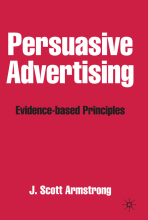Summary: Persuasive Advertising Evidence-Based Principles | 9781403913432 | J Scott Armstrong
- This + 400k other summaries
- A unique study and practice tool
- Never study anything twice again
- Get the grades you hope for
- 100% sure, 100% understanding
Read the summary and the most important questions on Persuasive Advertising Evidence-based Principles | 9781403913432 | J. Scott Armstrong
-
1 Types of evidence
-
1.1 Casual observation
-
Under what circumstances provides casual everyday observation useful evidence?
In simple situations when feedback is clear and frequent. Unfortunately, there are a few situations like this in advertising.
Falls short when advertisers do not have or use accurate timely, well-summarized feedback about the outcomes of their procedures relative to alternatives. -
What are two drawbacks of casual observation as typical practice
1) Knowledge based on this practice is ineffective when many conditions are involved, very difficult to determine how each condition relates to the effectiveness.
2) The practice can suffer when short-term success conflicts with long-term results. -
What is the problem with experience and beliefs for advertising experts?
Experience tends to reinforce beliefs even when they are wrong. Advertising experts are also prone to this problem. If they think that an advertising technique will work, their experience is likely to confirm this belief. -
Name two problems for relying on experts:
- It's hard to develop principles in situations that involve several conditional factors.
- Experts often overlook conditions when giving advice. -
1.2 Empirical evidence
-
When is empirical evidence rather than casual observation needed?
When situations are complex, empirical research is needed to identify how conditions affect the outcomes of various actions. -
What are the three types of empirical evidence?
Non-experimental data, quasi-experimental data and experimental data. -
1.2.1 Non-experimental data
-
When is non-experimental data useful?
In simple situations that involve only one or two minor conditions, especially when they have a strong effect, e.g. use of "brand-differentiating message".
In complex situations, non-experimental data can be misleading. -
1.2.2 Quasi-experimental data
-
What is quasi-experimental data?
Approach where the research design controls for some, but not all variables, in comparisons of different ways of advertising. For example two ads for the same product, brand and media. Things that differ may be contrast, specific benefits etc. -
What type of brand awareness improves when applying the principle to mention the brand in the headlines?
Recall is better. -
What is true about the length of text in an advertisement given the condition of low vs. high involvement for products?
Ads for low-involvement products were more effective with short headlines than long ones, while ads for high-involvement products were more effective with longer headlines.
- Higher grades + faster learning
- Never study anything twice
- 100% sure, 100% understanding
































